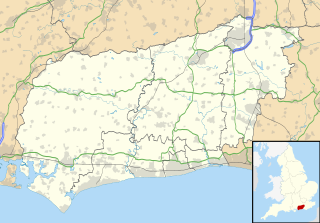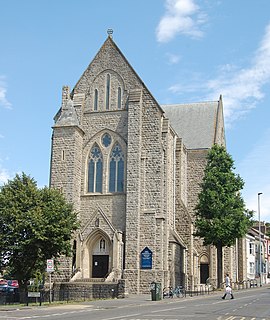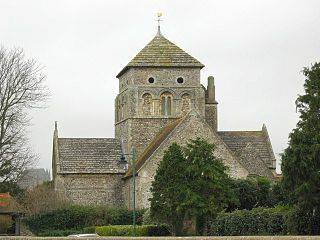History
The settlement of Old Shoreham developed inland from the English Channel and next to the east bank of the River Adur. Its focus was the 10th-century St Nicolas' Church. [2] Later development filled the gap between the village and the sea, and the growth of trade from its harbour in the 18th and 19th centuries brought prosperity to what was by then a small town. [3]
By the mid-19th century, two large Anglican churches were supported—St Nicolas' Church had been joined by the substantial St Mary de Haura Church [2] —but Roman Catholics had no place of worship. Around that time, a priest began to travel in from nearby Worthing to celebrate Mass at a house in Surry Street; in 1870 this arrangement moved to a former schoolroom on a site between John Street and Ship Street. [4] The land on which this stood had been acquired in the 1860s by the former Vicar of Shoreham, Reverend William Wheeler. He had left the Church of England and was received into the Roman Catholic Church in 1855, [5] and donated the land to enable a permanent church to be built. [4]
The funds to build the church came from Augusta, Duchess of Norfolk. She had married into the Dukedom of Norfolk, England's most important Roman Catholic family, in 1839; [5] her husband, Henry Fitzalan-Howard, 14th Duke of Norfolk, was the Lord of the Manor and lived nearby at Arundel Castle, the ducal seat. [5] Architect Charles Buckler, who was responsible for several Roman Catholic churches in Sussex, [6] was commissioned to design and build the church. [5] The building, described as "large, rather severe ... [and] assertive", [5] was consecrated and opened in 1875. A presbytery was added on the east (John Street) side, in a matching style, in 1877. [4] [5] Its capacity was approximately 200, and it cost £5,000 (£482,000 as of 2022). [7] [8] It was registered for marriages in April 1877. [9]
Architecture
Charles Buckler used the Decorated Gothic style, imitative of 13th- and 14th-century churches, for his design for St Peter's Church. The structure is of cobbled flint dressed with ashlar. [1] [4] [10] It lacks a spire or tower, but there is a bell-tower at the west end of the roof, [4] which is tiled and gabled. [1] There are four large lancet windows in the north and south walls, separated by buttresses; until the building's conversion from a nursing home into flats, these had elaborate tracery. [10] As originally built, the church had a four-bay nave and two further bays in the chancel, which also had a transept. A porch led into the nave on the west side. [1] Inside, below the roof trusses, there was a gallery at the west end. Fittings included a reredos and a marble altar. [1]
The building today
The church was closed and sold for redevelopment in 1982. [10] It was converted into a nursing home, retaining most of its ecclesiastical features including the intricate window tracery. [1] [10] [11] The latter was lost when the building was converted into flats in 2002, being replaced with plain modern windows instead, [10] but there has otherwise been little structural alteration. The flats are named "St John's Court"—a reference to the former name of John Street. "St John" referred to the Knights of St John Hospitallers, who had been active in Shoreham since the mid-12th century. [11]
English Heritage granted the former St Peter's Church Grade II listed status on 16 August 1983. [1] Such buildings are defined as being "nationally important and of special interest". [12] As of February 2001, it was one of 106 Grade II listed buildings, and 119 listed buildings of all grades, in Adur district. [13]
The new St Peter's Church
A new church—a low building with a rectangular plan—was built just north of its predecessor after it closed in 1982. Construction started in 1983. [14] The building, which stands on the corner of West Street and North Street, is on the site of a Roman Catholic school which had closed and moved elsewhere in the town in the 1960s. Before that, a 17th-century house stood on the site; its grounds extended some distance to the north. [15] [16]
The church is part of the parish of Our Lady Queen of Peace, Adur Valley, which covers three Roman Catholic churches in the area (the others are at Steyning and Upper Beeding in the neighbouring district of Horsham). One priest serves all three. [17]
Two Masses are celebrated every Sunday, and on Holy Days of Obligation an evening Mass is said. [18]

West Sussex is a county in South East England on the English Channel coast. The ceremonial county comprises the shire districts of Adur, Arun, Chichester, Horsham, and Mid Sussex, and the boroughs of Crawley and Worthing. Covering an area of 1,991 square kilometres, West Sussex borders Hampshire to the west, Surrey to the north, and East Sussex to the east. The county town and only city in West Sussex is Chichester, located in the south-west of the county. This was legally formalised with the establishment of West Sussex Council in 1888 but within the ceremonial Sussex. After the reorganisation of local government in 1974, the ceremonial function of the historic county of Sussex was divided into two separate counties, with the western half becoming West Sussex and the eastern half East Sussex. The existing East and West Sussex councils took control respectively, with Mid Sussex and parts of Crawley being transferred to West Sussex administration from East Sussex. In the 2011 census, West Sussex recorded a population of 806,900.

The Adur is a river in Sussex, England; it gives its name to the Adur district of West Sussex. The river, which is 20 miles (32 km) long, was once navigable for large vessels up as far as Steyning, where there was a large Saxon port, but by the 11th century the lower river became silted up and the port moved down to the deeper waters at the mouth of the river in Shoreham-by-Sea.

Kingston by Sea, also known as Kingston Buci, Kingston Bucii or simply Kingston, is a small area in the Adur district of West Sussex, England. Although it is now part of a continuous urban area, its origins lay in an ancient village and parish church between Southwick to the east, Shoreham-by-Sea to the west and the mouth of the River Adur to the south. St Julian's Church survives, and its parish perpetuates the ancient "Kingston Buci" name.

St John the Baptist's Church is a Roman Catholic church in the Kemptown area of the English city of Brighton and Hove. It was the first Roman Catholic church built in Brighton after the process of Catholic Emancipation in the early 19th century removed restrictions on Catholic worship. Located on Bristol Road, a main road east of the city centre, it is one of 11 Catholic churches in Brighton and Hove. The Classical-style building, which was funded by Maria Fitzherbert and completed in 1835, has been listed at Grade II* by English Heritage for its architectural and historical importance.

St Joseph's Church is a Roman Catholic church in the Elm Grove area of Brighton, part of the English city of Brighton and Hove. It is one of eleven Roman Catholic churches in the city. The church was built in several stages, and outstanding debts meant that its official dedication did not take place until 1979. It has been listed at Grade II* by English Heritage in view of its architectural importance.
The Rape of Bramber is one of the rapes, the traditional sub-divisions unique to the historic county of Sussex in England. It is the smallest Sussex rape by area. Bramber is a former barony whose original seat was the castle of Bramber and its village, overlooking the river Adur.

St Julian's Church is an Anglican church in Kingston Buci in the district of Adur, one of seven local government districts in the English county of West Sussex. Kingston Buci was a Saxon-era village near the English Channel coast between Southwick and Shoreham-by-Sea; little remains from that period, and modern residential development has obscured the old boundaries between the settlements, but the church retains its mostly 13th-century appearance and serves a parish which retains the ancient Kingston Buci name. English Heritage has listed it at Grade I for its architectural and historical importance.

St Michael and All Angels Church is an Anglican church in the town of Southwick in the district of Adur, one of seven local government districts in the English county of West Sussex. Some Saxon-era structural work is still visible despite rebuilding work in the 12th and 13th centuries and in more recent times; and a church may have existed on the site as early as the 10th century—before the ancient settlement of Southwick even took that name. The church has been damaged by fire and bombing, but is still in active use as the area's parish church. English Heritage has listed it at Grade II* for its architectural and historical importance.

St Mary de Haura Church is an Anglican church in the ancient "New Shoreham" area of Shoreham-by-Sea in the district of Adur, one of seven local government districts in the English county of West Sussex. It was founded at the end of the 11th century as a large cruciform church which, due to its original scale, has been described as a collegiate church—a reflection of the port of Shoreham's importance at the time. The former east end of that building survives to form the present church, and much 12th-century work remains. It functions as Shoreham-by-Sea's "town church" for major religious and social events, as well as serving as the town-centre parish. English Heritage has listed it at Grade I for its architectural and historical importance.

St Nicolas Church is an Anglican church in Old Shoreham, an ancient inland settlement that is now part of the town of Shoreham-by-Sea in the district of Adur, one of seven local government districts in the English county of West Sussex. It was founded on a riverside site by Anglo-Saxons at the start of the 10th century, possibly on the site of a 5th-century predecessor. Some Saxon-era structural elements remain despite 12th-century additions made when Shoreham became prosperous, further extension in the 14th century and a Victorian restoration. The cruciform structure, with its solid central tower, features some unusual Norman-era carving. English Heritage has listed it at Grade I for its architectural and historical importance.

Erringham chapel is a former place of worship in the deserted medieval village of Old Erringham, north of Shoreham-by-Sea in the district of Adur, one of seven local government districts in the English county of West Sussex. Founded in the 11th century as a chapel of ease to St Nicolas' Church in the Saxon riverside village of Old Shoreham, it was in use for several centuries until depopulation caused Old Erringham to become unviable as a settlement. The chapel fell into ruin, and its remains have been incorporated into a barn on the farm which now occupies the site of the village. English Heritage has listed the remaining structure at Grade II for its architectural and historical importance.
The district of Adur, one of seven local government districts in the English county of West Sussex, has 119 buildings with listed status. The urbanised southern part of the district forms part of the Brighton/Worthing/Littlehampton conurbation, and most listed structures are in the three main centres of population: Southwick, Shoreham-by-Sea and Lancing. The towns have grown residentially and industrially in the 20th century, but all three have ancient origins as villages and manors on the banks of the River Adur and the English Channel coast. The rest of Adur district's territory is remote downland countryside with scattered farms and hamlets; some of their buildings also have listed status.

All Saints Church is the Anglican parish church of Roffey, in the Horsham district of the English county of West Sussex. The present church, built to serve the Victorian suburb of Roffey—part of the ancient market town of Horsham—replaced a schoolroom in which religious services had been held since 1856. Arthur Blomfield's Early English-style church, built of locally quarried sandstone and funded by a widow as a memorial to her late husband, was completed in 1878 and was allocated a parish immediately. Roman Catholic services were also held in the building to serve Roffey's Catholic population, but these ceased in the early 21st century. English Heritage has listed the church at Grade II for its architectural and historical importance.

The Church of St Thomas of Canterbury and English Martyrs is the Roman Catholic church serving St Leonards-on-Sea, a town and seaside resort which is part of the Borough of Hastings in East Sussex, England. The present church, which combines a plain, unadorned Gothic Revival exterior with a lavishly decorated interior featuring extensive early 20th-century paintings by Nathaniel Westlake, is the third building used for Roman Catholic worship in the seaside resort. James Burton's new town of 1827, immediately west of Hastings, was home to a convent from 1848; public worship then transferred to a new church nearby in 1866. When this burnt down, prolific and "distinguished" architect Charles Alban Buckler designed a replacement. The church remains in use as the main place of worship in a parish which extends into nearby Hollington, and has been listed at Grade II by English Heritage for its architectural and historical importance.

The Grade I listed Saxon church of St Botolph's at Botolphs, West Sussex, England, is situated in the valley of the River Adur and is now part of the Church of England parish of Beeding and Bramber with Botolphs. An earlier dedication to St Peter de Vetere Ponte is now lost, like the bridge over the Adur from which it took this ancient name. The church serves the mostly depopulated hamlet of Botolphs in the Horsham district of West Sussex. The church has fragments of medieval wall paintings. Architectural historian Ian Nairn comments that the Jacobean pulpit is "notable in a county which is poor in 17th century fittings".















